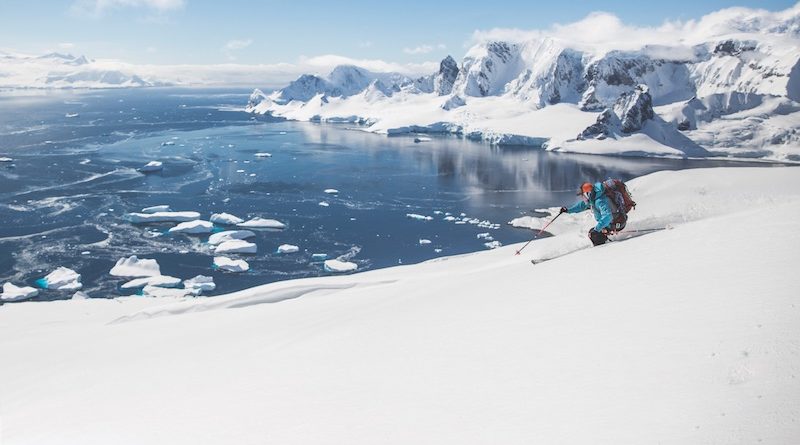Skiing at the Bottom of the World
Legendary extreme skier and Sugarbush Ambassador John Egan skis one of the last two continents on his bucket list.
PHOTOS BY TYLER WILKINSON-RAY
On November 9 of 2018, John Egan stretched climbing skins onto his skis, clicked into his touring bindings and looked around him. “It was a crystal-clear day and we had a beautiful skin ahead of us with a long approach into the mountains of Nansen Island, through two different valleys. It was also my dad’s birthday and he’d passed away recently so that made it especially memorable,” he says.
Remarkably for Egan—legendary extreme skier, Sugarbush’s Chief Recreation Officer and a long-time resident of the Mad River Valley—it was his first day skiing in Antarctica.
There are few places he hasn’t skied.
“I’ve really specialized in the Arctic and been up there maybe 20 or 30 times” he says. “It started when Paul Fremont Smith started GO—Greenland Outdoors—and invited me to go
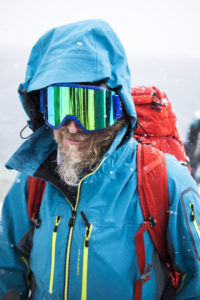
heli-skiing. Since then, I’ve helped the Inuit and other native people set up trails and guiding services in places ranging from Greenland to Siberia.”
Egan has laid down tracks in remote areas of Labrador and as far north as Baffin Island and Canada’s Ungava Bay. He’s also helped to set up ski guiding operations in Kamchatka, in the northwestern corner of Siberia. Up until last November he had skied five of the seven continents. Antarctica was his sixth. Africa remains the last. “That bucket list?” says Egan with a laugh, “It’s gotten down to a small coffee cup.”
Wearing only a sun shirt for a top, his face covered in sunscreen, Egan set off that day last November guiding his group of Vermonters ( Melody Blodgett, Jen Bennett, Steve Keyes and Egan’s wife, Barbara Friedsam) toward an unnamed mountain. “It was a bluebird day and… my face was totally covered because the sun will eat you alive.”
The group skinned in a single track, roped together as they covered an uncharted landscape of ice, rock and snow where crevasses could appear at any minute. “When we reached the top there was a plateau with a 360-degree view of nothing but snow and ice and peaks and the ocean beyond. It was so vast and beautiful.”
Pulling off their skins, the group arced turns down what was at times corn snow, at others, hardpack that tested even the Vermont contingent. They gathered at the shore, climbed in a Zodiac and headed back to their ship, the Ocean Explorer, for lunch.
Caption: 1. The first stop on the trip was the abandoned whaling station (top) on Deception Island, in the South Shetlands. 2. Most days brilliant sun made for near spring-like conditions and corn snow 3. Stoup skins with the ship in the background. 4. Lunch on the deck of the home ship. 5. A Leopard Seal poses for a portrait.
Antarctica has long been a bucket list destination for explorers and scientists and, now, for tourists and skiers. “My friend Doug Stoup invited me on this trip as a guide,” says Egan. “How could I say no? The trip was a who’s who of guides from around the world.”
Also along was native Vermonter Tyler Wilkinson-Ray, the Richmond-raised photographer and filmmaker behind T-Bar films whom many know from his film “2.5 Million,” which documented his University of Vermont buddy Aaron Rice as he set the record for most vertical uphill skied in a year. “I live in Colorado now and I’m used to seeing big, beautiful mountains but nothing prepared me for Antarctica,” said Wilkinson-Ray, who was hired to shoot the trip for Ice Axe Expeditions.
“The most astonishing thing was the raw beauty of being down there—the most jagged, rugged, impressive landscapes I have ever seen. It’s breathtaking and you never get used to it. It’s staggering.”
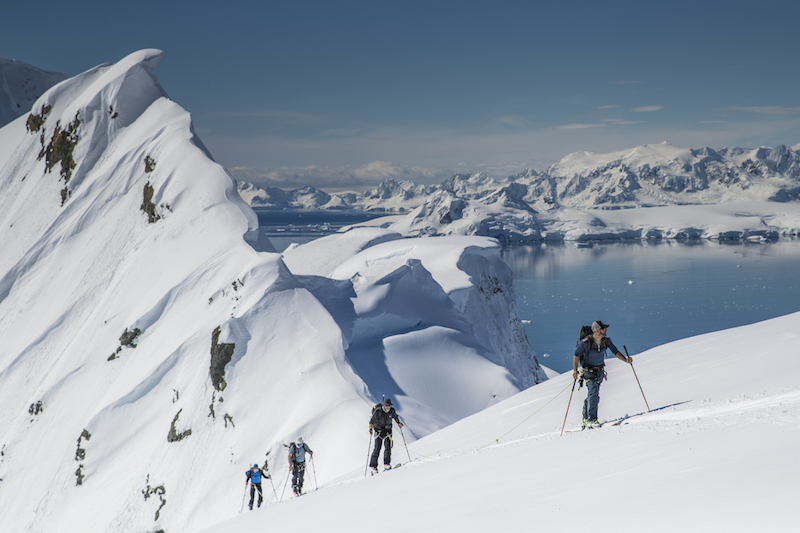
At the head of the all-star crew was Stoup, who runs Ice Axe Expeditions. Stoup has logged more miles on Antarctica than any skier. He’s skied to both the North and South Poles. In 2014, with Parker Liautaud—then a 19-year-old sophomore at Yale—Stoup set the world speed record for skiing from the coast to the South Pole. The pair pulled a 176-pound sled over 314.58 miles in 18 days, 4 hours and 43 minutes, National Geographic reported.
Stoup’s company, Ice Axe Expeditions, has been taking groups of 100 or so skiers and 27 guides to Antarctica since 2009, and smaller expeditions well before that. They now use Quark Expeditions’ Ocean Explorer, a ship designed to handle the icy conditions.
After acclimatizing, Egan and his crew boarded the ship in Ushuaia, Argentina. “We had the wind at our back and it only took us a day and a half to cross Drake Passage—one of the most notorious stretches of ocean on the globe,” says Egan. With that head start, they were able to make a stop at Deception Island, a volcanic island in the South Shetland Islands.
“I love volcanoes and really wanted to ski there,” Egan recalls. “Andrew McLean had been to Deception so there was plenty of route and crevasse intel,” Egan said, referring to the Utah backcountry guide and author of The Chuting Gallery, a guide to the steepest descents in the Wasatch.
“It was a perfect, stormy Antarctic day and here we are at this abandoned whaling station with snow swirling all around and it’s so windy we could barely get our skins on,” Egan said. “On other days we had to try to land twice with the Zodiac. All I could think of was Ernest Shackleton.”
In 1916, after his ship, Endurance was locked in the Antarctic ice for 10 months, Shackleton and 28 men piled into two open lifeboats hoping to reach the Deception Island whaling station. They came within 180 kilometers before they were blown off course and ended up at Elephant Island.
The skiers on the Ocean Explorer got a taste of what that was like: “We had days when our Zodiac was swamped and we were left with wet ski boots,” Egan says. “You can imagine what it must have been like for Shackleton’s team to be constantly wet and out in 20 degree weather.”
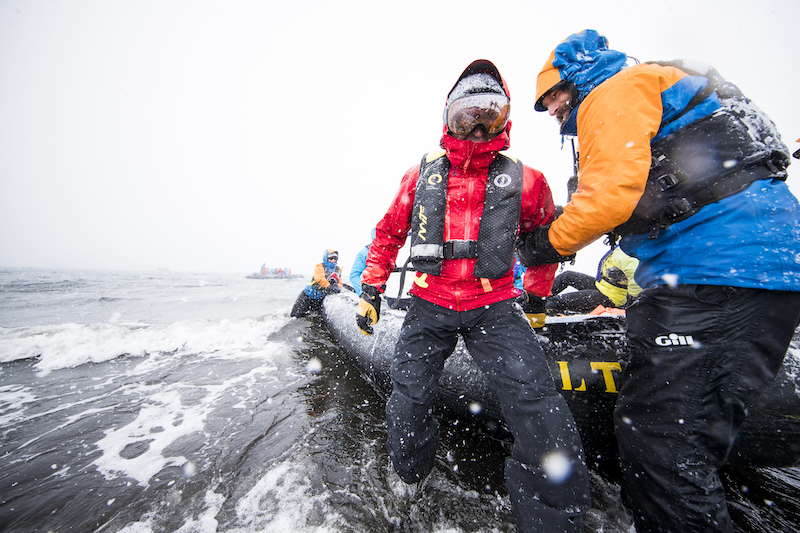
From Deception, the ship sailed south to the Palmer Archipelago, a series of islands off the northwest Antarctic Peninsula, an 800-mile stretch of volcanic mountains that rises steeply from the Southern Ocean. The guides would look for spots to land the Zodiacs—not an easy task with cliffs of glacial ice often rimming the shore and submerged icebergs to navigate around.
“The ship would move at night and we’d wake up and work our way around where the ice was. Some days it was so slick we used crampons on our skis and we were really
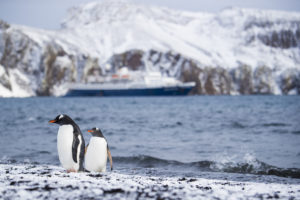
glad we’d been trained on the East Coast on hard snow. Other days we had corn and even fresh powder.” Starting at sea level the skiers climbed, at the highest, to about 4,000 feet.
There were times, too, said Egan that skiing played second fiddle to simply taking in the landscape. “It is so vast and big and beautiful. You could climb and skin and look forever and see nothing but whales and seals and sea lions and penguins. Or, when we got near the water, you could sometimes see whale bones at the bottom of the ocean 40 or 50 feet below you. Even though you know it’s been touched, it’s the most pristine landscape—no trash and no signs of other humans. Everest is one of the craziest and most remote places to go to and now it’s full of trash,” Egan says.
To keep Antarctica’s environment pristine, visiting ships have a strict protocol. “We spent much of the voyage from Ushuaia cleaning every piece of our gear and vacuuming every pocket of every jacket, pant and backpack,” says Egan. Before going ashore, everyone dipped their ski boots in a disinfecting solution. No food is allowed on Antarctica—not a scrap—and no waste can be left there. “You’d have to hold it or use a WAG bag and we’d come back to the ship at lunch every day. ”
One day, on returning to the ship the skiers found that the passage the crew had planned back out of their anchorage had been blocked by sea ice. Instead of skiing that afternoon, they would go looking for another passage out and if it was calm, the captain promised, guests could go for a swim.
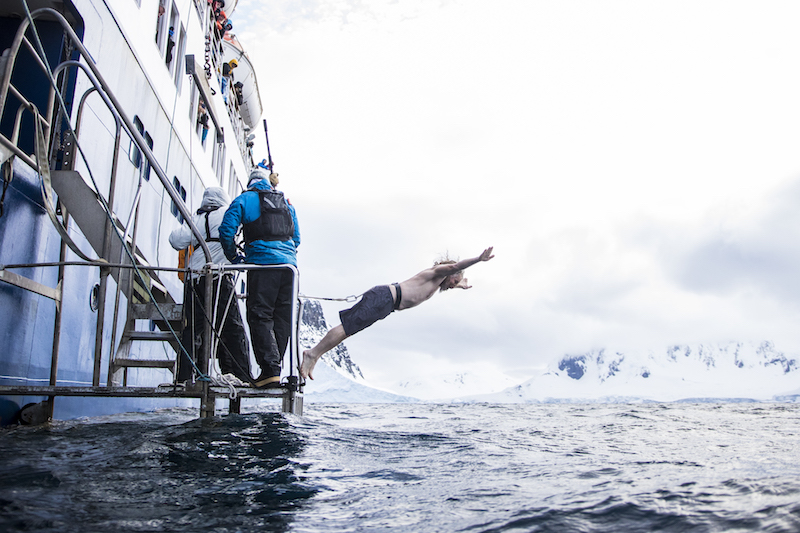
He wasn’t kidding. “About 60 of us, one by one, walked down the gang plank and dove into the coldest water I’ve ever felt. After about a second, my arms went numb,” Egan said. On other calm days, guests could take kayaks out to paddle among the icebergs.
The months between October and February are relatively mild on the peninsula, where temperatures hover in the 20s and can rise above freezing. And they are getting warmer. Scientists have found that since the 1950s, winter temperatures have risen a startling 10 degrees on the western side of the peninsula. Around the peninsula, colonies of penguins have been collapsing.
In 2019 Ice Axe’s Doug Stoup told Protect Our Winters, “In the Antarctic, rising water temperatures are causing dramatic changes to wildlife habitats, affecting the entire food chain from krill to penguins. At Ice Axe Expeditions, we will soon be forced to change the way we plan trips and design gear. In the near future, our polar trips might involve as much kayaking as they do skiing.”
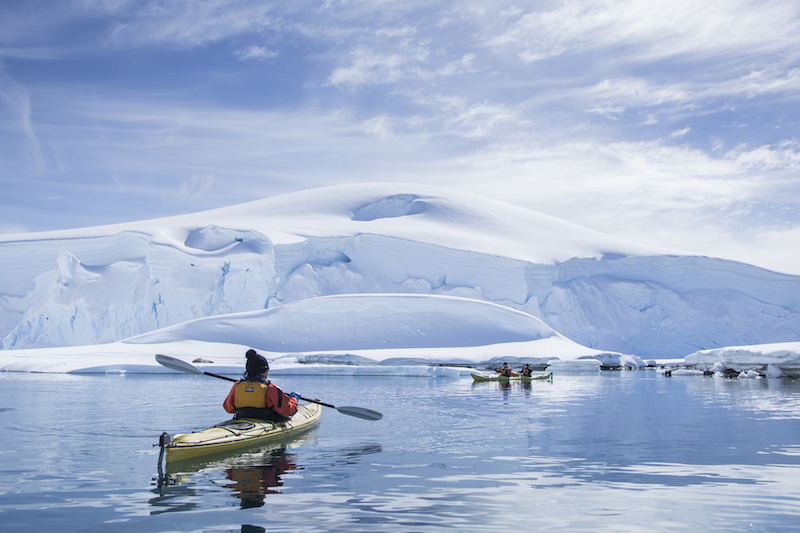
For the past year, scientists have been monitoring a fissure in the ice on the Brunt Ice Shelf that is predicted to break through any minute. When it breaks, it could launch a 660-square mile iceberg, releasing a piece 500 feet thick and twice the size of Manhattan into the sea, which would put rising sea levels just a little higher.
The trip back to Ushuaia was far from calm. “We had 40-foot waves and winds hit 99 knots (113 mph),” Egan says. “Some guests were violently seasick and stayed in their cabins. But I’d say for the most part the Vermonters enjoyed it. I spent a lot of it up on the bridge watching these waves rise up four stories and crash over us.” Egan pauses and then adds, “But I love extreme weather and extreme situations–weather wise and beauty wise.” And that’s why he plans to return in 2020.
Want to Go?
Ice Axe Expeditions’ next available ski cruise to Antarctica is in November 2020. The 13-day trip starts at about $12,000. Interested skiers are expected to fill out a form ahead of time documenting their experience in backcountry skiing and mountaineering. Ice Axe also organizes a 100-mile fat bike expedition to the South Pole and a smaller private ski touring trip for groups up to 8 on a sailing yacht, Australis. For more information, see iceaxe.tv
Featured Photo Caption: Extreme skiing legend John Egan, a long way from his home in Vermont’s Mad River Valley, making his first turns on the Antarctic Peninsula.

